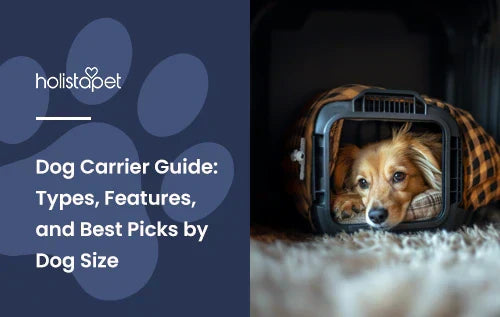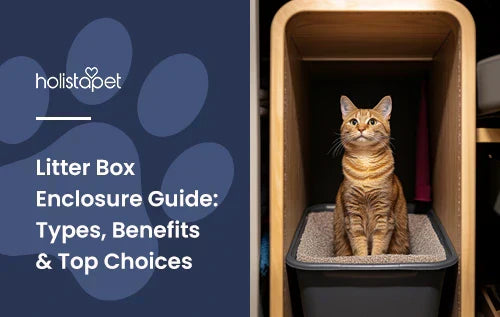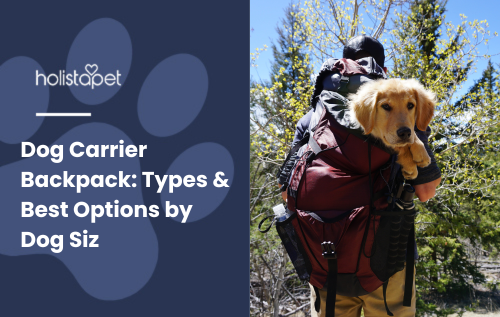Did you know not all dog carriers are allowed on planes, even if they look like they'd fit? Choosing the right dog carrier can make travel smoother for both you and your pup.
Some carriers slide neatly under an airplane seat, while others are better for car rides or long walks through the airport. You'll also find differences in shape, weight limits, and how easily they open or close.
A soft-sided carrier might work well for short trips, but a sturdier option may offer better safety. In this guide, you'll learn what makes a pet carrier a smart choice based on your dog's size, needs, and travel plans.
What Is a Carrier for Dogs and When Do You Need One?

A pet carrier is a soft or structured bag made to carry your dog safely and comfortably. It gives pets their own space and keeps them calm in busy places like airports or vet offices. You might need one for air travel, daily errands, or just a long walk around town. Some carriers are soft with mesh sides, while others feel more like a tiny kennel. No matter the style, a pet carrier makes outings with your pup much easier.
Common Uses: Travel, Vet Visits, and Safety
A good carrier is more than just a way to carry your pup from point A to point B. It offers comfort, protection, and a sense of control in places that can feel overwhelming. The right carrier keeps your dog secure and calm, no matter where the day takes you.
Air Travel and Flights
Flying with your pet comes with rules, and most airlines require an airline approved carrier that fits under the airplane seat. These carriers are designed for comfort and safety during the flight. Look for soft materials, breathable mesh panels, and a flexible frame that allows the carrier to slide under tight airplane seats without losing shape. A cozy liner and secure zippers help your dog stay calm through boarding, turbulence, and landing.
Vet Visits and Checkups
Vet visits can feel overwhelming with all the strange scents, odd sounds, and other pets in close quarters. A secure pet carrier acts like a safe bubble, giving your pooch a quiet space to hide and relax. Soft-sided models with top entry make it easy for the vet to gently remove your dog without added stress. Plus, having a familiar carrier during appointments helps your dog feel more at ease over time.
Car Rides and Long Road Trips
Whether it is a short ride across town or a long road trip, a proper carrier keeps your dog from sliding around with every turn or sudden stop. Some carriers are designed with crash testing in mind, giving you peace of mind during longer drives. A padded base, secure seatbelt straps, and plenty of airflow turn the back seat into a safe travel space. This helps keep your pet safe, calm, and comfy until you reach your destination.
Carrier vs. Crate vs. Backpack – What's the Difference?
Not every pet travel product works the same way. Some are made for smooth air travel, while others are better for car rides, hikes, or even staying at home. Knowing the difference helps you choose what works best for your pooch and the type of trip you have planned.
Carrier
A carrier is typically soft-sided, lightweight, and built for short outings or flights. It's the best choice when your pet needs to fit under an airplane seat. Many models include mesh panels or a mesh window for airflow and visibility. These carriers often come with shoulder straps, side zippers, and flexible frames that hold their shape without taking up too much space.
Crate
A crate is usually large, rigid, and offers more structure for dogs who need extra room to stand, turn, or lie down. Hard sided kennels are common for car transport or cargo airline use. They are more durable and can withstand bumps or motion during long road trips. Crates are also useful at home as a resting spot or training tool, but they are not ideal for quick errands or tight spaces.
Pet Backpack
A pet backpack lets you carry small dogs on your back, making it easy to move through crowds or busy airports. These are great for hands-free travel and usually include padded shoulder straps, storage pockets, and ventilated openings. Some even double as carriers, giving you the option to switch between walking and carrying. Just keep in mind that they work best for pets under a certain weight, usually up to 15 pounds.
What Makes a Pet Carrier Great?
A great carrier does more than just hold your pet. It needs to be strong, safe, and easy to carry. The best pet carriers keep your pup cozy, protect them in tight spaces like airplane seats, and make travel feel simple for both of you.
Key Features to Look For (Ventilation, Safety, Comfort)
Not all carriers are built the same. These small details make a big difference for your pet's safety and comfort.
- Good Ventilation. A mesh window or mesh panels allow your dog to breathe easily and stay cool. Look for designs that let air flow through more than one side.
- Built-In Safety. Features like a flexible frame, strong zippers, and secure straps help keep your pet inside during bumps or quick stops. Some bags even go through crash testing.
- Comfortable Interior. A soft, plush lining and padded bottom give your dog a smooth ride. If the interior feels cozy and stable, they are less likely to get upset on the trip.
Airline Approved vs. Everyday Use
Airline approved pet carriers must fit under airplane seats and meet size and safety rules set by most airlines. These carriers are made for air travel, often with flexible sides, soft padding, and secure closures.
On the other hand, everyday pet carriers give more space and might not fit as a carry on. They're great for vet visits or trips around town but may not pass airline checks. Always double check with the airline before you fly.
Carrier Materials – Soft-Sided, Hard-Sided, and Hybrid Options
The material of your carrier plays a big role in how it works for different types of trips. Each style offers something useful.
- Soft-Sided Carriers. These are lightweight and often fit under airplane seats. A soft-sided carrier is easy to carry and offers mesh panels for airflow and easy access for your pet.
- Hard-Sided Kennels. These are stronger and better for long road trips or larger dogs. Hard sided kennels give more protection but take up more room and feel heavier.
- Hybrid Carriers. These mix both soft and hard materials. You get the shape support of a hard shell and the light weight of soft fabric, which makes it a great option for flexible transport needs.
Types of Carriers Explained
Not every carrier works the same way, and that is a good thing. Some are soft and easy to pack. Others are sturdy and shaped like a small kennel. You will also find options with wheels or ones made for the car. Picking the right carrier depends on your travel plans, your dog's size, and where you plan to go next.
Soft-Sided Carriers (Flexible and Lightweight)
A soft-sided carrier is a top choice for air travel, short vet visits, and everyday errands. It is light to carry, easy to fold, and simple to store when not in use. These carriers often come with mesh panels or a mesh window, giving your pet a clear view and steady airflow throughout the ride. That helps reduce agitation and keeps them cool in tight spaces.
A good model will have a flexible frame, which allows the carrier to keep its shape while also squeezing under tight airplane seats. Some designs even let the sides unzip, expanding the space mid-flight so your pet can stretch out a bit more. This feature is especially helpful for longer trips, giving your dog more comfort without needing a larger bag.
Hard-Shell Carriers (Maximum Protection)
Hard sided kennels are the go-to for dogs who need extra protection or for pets traveling in checked cargo. The rigid shell guards against sudden bumps, tight corners, or rough landings, keeping your dog steady during unpredictable transport. These carriers often have locking doors made of steel and ventilation slots on all sides, so your pet can breathe easy and stay calm.
Because they are more solid, they give dogs a strong surface to lean on or stand without wobbling. They work best for long road trips, cross-country moves, or shipping by plane, but be sure to double check size and material rules with your airline. Keep in mind, they are bulkier and not as convenient to carry, so they may not be the best for everyday use.
Wheeled Carriers (Easy to Transport)
Wheeled pet carriers are perfect for travelers who want to glide through airports without heavy lifting. These bags roll smoothly across flat surfaces, saving your back and shoulders from strain. They usually have a telescoping handle like a suitcase, so you can pull it behind you with ease.
Many of these carriers also include mesh panels for airflow, soft liners for comfort, and pockets to hold small items like treats, wipes, or documents. Just make sure the carrier is well-balanced and doesn't tip when you turn or stop quickly. For smooth trips through crowded terminals, a steady wheeled carrier can be a game changer.
Car Seat Carriers for Road Trips
For long road trips, car seat carriers offer both comfort and safety in one neat setup. These carriers often include a secure strap system that attaches to the vehicle seat, keeping the carrier in place if you brake suddenly. This not only protects your pet but also keeps the ride smooth and controlled.
Look for models that have been tested for crash protection and feature a padded interior to help reduce pressure on joints. Once you arrive, many carriers turn into a soft resting place, making your pup feel at home without extra gear. Easy to clean and built for travel, these carriers are a smart pick for car-loving dogs.
Best Carriers for Dogs to Consider
Not all pet carriers are created equal, especially when you're shopping for a good fit based on your dog's size. From tiny toy breeds to medium pups, the right carrier keeps them comfy and pet-safe during any trip.
Below are top picks that work well for air travel, vet visits, or a ride in the car. Each carrier here skips the backpack style and focuses on smart design and practical features.
Best Small Dogs Carriers
Small pups need more than just a cute bag. These pet carriers are lightweight, durable, and shaped to keep your dog comfortable, secure, and calm in busy settings.

- Sherpa Original Deluxe Pet Carrier. This soft-sided carrier is airline-approved and has a smart spring wire frame that bends to fit under airplane seats. It includes locking zippers, a mesh window, a washable liner, and a waterproof base. The strap makes it easy to carry by hand or over your shoulder. It also features a luggage strap that can slide over suitcase handles or be used for car seatbelt safety.

- Henkelion TSA-Approved Soft-Sided Carrier. Made with durable polyester and four mesh panels, this lightweight pet carrier works well for pets under 15 pounds. It folds flat for easy access and storage, includes padded straps, and has safety loops that double as a seat belt option. It is compact, comfy, and fits snugly under airline seating.

- AmazonBasics Hard-Sided Pet Carrier. This sturdy hard-sided kennel is perfect for toy breeds that need more structure and protection. The two-door design allows front or top entry, with secure latches and good airflow. Made from heavy-duty plastic with a steel door, this carrier stands up to long road trips and short vet runs. Always check your pet’s measurements before picking a carrier.
Best Medium Dog Carriers
Medium-sized dogs need carriers with more space, stronger parts, and features built for real travel. These picks give your dog room to move, rest, and stay secure, whether you're going across town or across the country.

- Petmate Two Door Top Load Kennel. This hard sided kennel has a roomy top-load design that makes it easier to place your dog inside without a struggle. Built from strong plastic with steel doors, it includes side vents for airflow and a foldable handle. It is airline approved for cargo travel and easy to clean, thanks to its molded base that keeps spills off your dog.

- EliteField Soft-Sided Pet Carrier. This soft-sided carrier is made with lightweight, waterproof fabric and includes mesh sides for airflow and light. The padded interior bed is removable, and the built-in seat belt loop adds safety during car trips. It also has extra pockets and straps for travel convenience, making it a smart choice for busy airports or vet visits.

- SportPet Designs Rolling Travel Pet Carrier. This rolling carrier works like a home crate and a travel buddy in one. It comes with attachable wheels, dishes, and required gear for flying with airlines. The impact-resistant shell and strong door keep your dog secure, and the built-in moat helps pull accidents away from your pet's bed.
Best Large Dog Carriers
Large dogs need space, strength, and solid features that hold up to long-distance travel. These top picks offer comfort and safety while keeping your big pup secure on the move.

- Petmate Sky Kennel. Built for air travel, this heavy-duty carrier uses impact-resistant plastic and wire vents to keep airflow steady. It meets most airline rules and comes labeled with "Live Animals" on the outside. The non-corrosive parts and steel door give it lasting power, and the eco-friendly materials are a thoughtful bonus.

- Aspen Pet Porter Heavy-Duty Carrier. This kennel is simple but strong. It has side vents for airflow, a plated steel door with a squeeze latch, and easy-to-clean plastic. It also meets airline guidelines and includes a three-in-one compartment to store treats or supplies on the go.

- Feandrea Collapsible Portable Travel Dog Crate. This soft-sided carrier works well for large breeds that need flexibility. The frame is sturdy, the zippers lock from the inside, and the fleece pad keeps the interior soft. With three doors, two storage pockets, and a foldable shape, this carrier is easy to store, clean, and move when needed.
Sizing Your Carrier Properly
Choosing the right carrier size is not just about weight. Your pet needs room to breathe, stretch, and relax. A carrier that is too tight can cause stress, while one too big may feel unsafe. Always double-check your dog's measurements before picking a carrier for any trip or air travel.
Measuring Length, Height, and Weight
Getting the perfect fit means knowing your pet's size from all angles. With a flexible tape measure in hand, follow the steps below.
- Length: Use a tape measure to go from your dog’s nose to where the tail connects to the body.
- Height: Measure from the ground to the top of the head or ears.
- Weight: Weigh your dog and compare it to the carrier's limit.
Check both the weight limit and internal dimensions. Most carriers list size guides, but it helps to measure first, not guess later.
Why Room to Turn and Lie Down Matters
A pet carrier should feel like a small room, not a tight box. Sure, your pet might squeeze through the door, but once inside, they need enough room to shift positions, lie down fully, and turn around without hitting the sides. Cramped spaces can cause discomfort, restlessness, and even muscle tension during long road trips or flights.
Giving your dog enough space helps them feel safe and in control. It allows for natural movement, which keeps them calm and better rested. A roomy interior paired with a soft bed or liner not only adds comfort but also lowers the risk of pressure on joints, especially for older dogs. When your pooch can move freely, the whole trip becomes a lot easier for both of you.
When to Use a Carrier for Comfort and Safety
A good carrier option does more than just help you carry your pet from one place to another. It can make loud spaces feel calm, tight corners feel roomy, and new places feel familiar. Whether it is a visit to the vet or a trip across the country, the right carrier adds both comfort and safety for your pup along the way.
Vet Visits, Road Trips, or Crowded Spaces
Some moments call for extra protection and a cozy spot your dog can count on. That is where the right carrier helps most.
- Vet Visits. Busy waiting rooms can be overwhelming. A secure pet carrier gives your dog a quiet spot and reduces nervous pacing before the exam.
- Road Trips. For long drives, a safe carrier keeps your dog from sliding around. It also makes long road trips more relaxing with a soft base and secure strap options.
- Crowded Places. In busy stores or airports, a carrier lets you move your dog safely through tight spaces. Look for easy-access zippers and soft pockets to keep things organized.
Older Dogs or Dogs With Mobility Issues
As dogs age, simple outings can become challenging. Joint aches, reduced mobility, and slower movement make it harder for them to keep up with daily activities. A well-chosen carrier for dogs can offer the support they need without leaving them behind.
A soft-sided carrier works like a mobile bed, letting your senior pup rest while staying close to you. The padded interior cushions their body, which helps relieve pressure on sore spots and stiff legs. It also prevents overexertion during long trips or extended time outside.
Look for features that provide both comfort and stability:
- Plush Base. A soft, padded bed gives older dogs relief from hard surfaces.
- Extra Room. Allows them to adjust their position or lie flat without feeling cramped.
- Wide Openings. Easy access lets you lift them in or out gently without bending their legs.
- Supportive Shape. A flexible frame keeps the carrier's shape steady without sinking in.
With the right carrier, older dogs can still enjoy car rides, vet visits, or family adventures without discomfort. It is a simple way to keep them involved, even when their legs need a break.
How to Get Your Dog Used to a Carrier
If your dog sees the carrier and bolts in the other direction, you're not alone. The good news? You can help your pooch feel more comfortable with a few simple steps. With some time and tasty rewards, their carrier can turn into their favorite cozy hangout.
Gradual Introduction and Positive Reinforcement
The goal is to make the carrier feel familiar, not forced. A few daily routines can help your dog feel safe inside.
- Let the Carrier Stay Out. Keep the pet carrier in a spot your dog visits often. Leave the door open so they can explore on their own.
- Reward Calm Behavior. Use soft treats and happy praise when they step near or inside. Keep things light and fun so they want to try again.
- Practice Makes Progress. Keep it short at first, then slowly work your way up. Sit nearby, stay relaxed, and keep the vibe easygoing.
Using Treats, Familiar Scents, and Calming Aids
Comfort takes more than practice. Using items your dog already loves can help build trust with their carrier.
- Toss in Treats They Love. Place small treats inside the carrier as a surprise snack. Let them find the goodies while they explore the space on their own terms.
- Use Familiar Scents. A blanket, toy, or old shirt that smells like home gives the interior a comforting feel. This adds security and makes the space feel like theirs.
- Try Calming Chews. HolistaPet's CBD Calming Chews are made with chamomile, L-tryptophan, and broad-spectrum CBD. These ingredients may help ease nervous behaviors and support balanced moods. They're a tasty mix of sweet potato and peanut butter that your pooch will happily snack on before a trip.
- Support Daily Wellness with HolistaPet CBD Wellness Treats. These daily treats are packed with sweet potatoes, blueberries, flax seeds, and hemp seed powder. They include CBD for natural support and work well to keep your pet feeling calm and balanced in new spaces. Use them to promote steady energy before travel or crate time.
Canine Carriers FAQ
Got a few last-minute questions before you pick the perfect carrier? These quick answers clear up common concerns and help you travel smarter with your pet.
Are Pet Carriers Safe for Long Trips?
Yes, a well-made carrier is a safe option for long road trips and even air travel, as long as it's the right fit for your pet. A cramped carrier can cause agitation or soreness, so always choose one with enough room to lie down, stand, and turn comfortably. The inside should have a plush liner or padded bed to cushion your dog during bumps or sudden stops.
Breaks are just as important. Try to stop every couple of hours so your dog can move around, stay hydrated, and take a bathroom break. Look for tested models with solid zippers, a sturdy strap, and plenty of airflow through mesh panels or windows. These features help your pooch stay relaxed and safe on the move.
Can Dogs Sleep in Carriers Overnight?
Many dogs can sleep in a carrier overnight if it feels like a calm, familiar space. The interior should have a padded base or soft bed that supports the body and cushions pressure points. Dogs need enough space to stretch out without feeling squished. If the carrier is too small or lacks ventilation, it may not be safe for longer rest.
For nighttime use, choose a quiet spot away from heavy foot traffic or loud sounds. Make sure the carrier stays cool and has breathable fabric or mesh panels. Add a favorite toy or blanket for comfort. If your dog feels settled and cozy, they can easily get a full night's sleep without stress.
What Size Carrier Does My Dog Need for a Flight?
Flying with your dog means sticking to strict airline rules. To avoid last-minute surprises, you need the right size and style of carrier. Here's what matters most when booking that next flight.
- Follow Airline Sizing Rules. The carrier must fit under the airplane seat in front of you. Most airlines list size limits for in-cabin travel, so always double-check those before your trip.
- Check for Breed Restrictions. Some flat-faced dogs or large breeds may not be allowed to fly in-cabin. Always review each airline's rules if your pet falls into these categories.
- Soft vs. Hard Carriers for Flights. A soft-sided carrier with a flexible frame is usually the best option for air travel. It can slightly squish to fit tight spots while keeping your pet safe and comfortable.
How Long Can a Dog Stay in a Carrier?
Most dogs can stay in a carrier for about four to six hours at a time. That range depends on the dog's age, bladder control, and how comfortable they feel inside the carrier. Young puppies and older dogs often need more frequent breaks, so be sure to schedule quick walks or bathroom stops on longer drives.
The interior should have soft padding, enough room to turn and stretch, and steady airflow through mesh panels to prevent overheating. If your pooch gets restless, try placing a favorite toy or blanket inside to help them settle. On flights, ask your airline about pet relief areas if you have a layover, and avoid back-to-back travel days when possible.
What's the Best Carrier for Nervous or Anxious Dogs?
A nervous dog needs a carrier that feels more like a safe den than a travel bag. Choose a soft-sided carrier with a padded base, quiet zippers, and a mesh window that lets them see you while staying tucked away. This setup reduces sound, movement, and light—three big stress triggers during travel.
You can also boost comfort with calming support. HolistaPet's CBD Calming Chews are made with chamomile and broad-spectrum CBD to help your pet stay relaxed during car rides or air travel. These are simple, natural ways to keep your dog calm without making things feel forced.
Are Pet Carriers TSA-Approved Automatically?
TSA does not officially "approve" any pet carrier, but they do expect certain features during the screening process. Your carrier should allow easy access for inspection, meaning the top or side should open fully so TSA agents can safely check the interior. If the carrier makes it hard to remove or secure your pet, it could slow things down at airport security.
What really matters is airline approval. TSA focuses on safety and visibility, but each airline has size and design rules for carry-on carriers. Look for models labeled airline-approved, and double-check that the dimensions match your specific airplane seat. A little prep makes a big difference once you get to the airport.
Final Thoughts – Choosing the Best Carrier for Your Pup
Picking the right carrier is all about comfort, safety, and knowing what your pet needs. From soft-sided bags with mesh panels to sturdy crates built for long road trips, the best carrier is the one that fits your pooch and your travel plans. Always check airline rules, measure your pet properly, and plan breaks for longer outings.
And while you're at it, don't forget the extras that make travel smoother like calming CBD treats, wellness chews, or pet care products for dogs and cats. A relaxed pet means an easier trip for everyone. Whether you're flying across the country or heading to the vet, the right carrier and a little prep go a long way.


 CBD Oil for Dogs - Fast Acting
CBD Oil for Dogs - Fast Acting
 Chicken Flavored CBD Oil For Dogs - Easy Dose
Chicken Flavored CBD Oil For Dogs - Easy Dose
 Salmon Flavored CBD Oil For Dogs - Highly Rated
Salmon Flavored CBD Oil For Dogs - Highly Rated
 CBG Oil for Dogs and Cats - Loved by Thousands
CBG Oil for Dogs and Cats - Loved by Thousands





Leave a comment
All comments are moderated before being published.
This site is protected by hCaptcha and the hCaptcha Privacy Policy and Terms of Service apply.